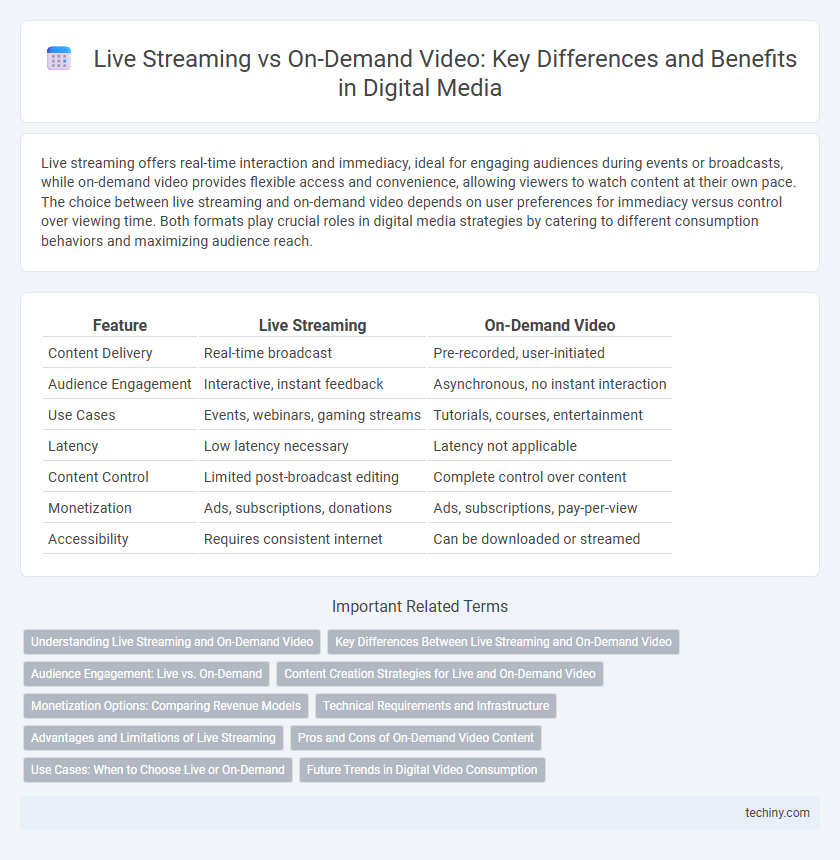Live streaming offers real-time interaction and immediacy, ideal for engaging audiences during events or broadcasts, while on-demand video provides flexible access and convenience, allowing viewers to watch content at their own pace. The choice between live streaming and on-demand video depends on user preferences for immediacy versus control over viewing time. Both formats play crucial roles in digital media strategies by catering to different consumption behaviors and maximizing audience reach.
Table of Comparison
| Feature | Live Streaming | On-Demand Video |
|---|---|---|
| Content Delivery | Real-time broadcast | Pre-recorded, user-initiated |
| Audience Engagement | Interactive, instant feedback | Asynchronous, no instant interaction |
| Use Cases | Events, webinars, gaming streams | Tutorials, courses, entertainment |
| Latency | Low latency necessary | Latency not applicable |
| Content Control | Limited post-broadcast editing | Complete control over content |
| Monetization | Ads, subscriptions, donations | Ads, subscriptions, pay-per-view |
| Accessibility | Requires consistent internet | Can be downloaded or streamed |
Understanding Live Streaming and On-Demand Video
Live streaming delivers real-time video content, allowing viewers to engage with events as they happen, making it ideal for sports, webinars, and live performances. On-demand video provides users the flexibility to watch content anytime, offering control over playback with features like pause, rewind, and fast-forward, suited for tutorials, entertainment, and educational materials. Both formats utilize Content Delivery Networks (CDNs) to ensure smooth streaming experiences, but live streaming demands lower latency and higher bandwidth to minimize delays.
Key Differences Between Live Streaming and On-Demand Video
Live streaming delivers real-time content to viewers, fostering immediate interaction and engagement, while on-demand video allows users to access pre-recorded content anytime, offering convenience and flexibility. Live streaming relies on low-latency technology and robust bandwidth to ensure seamless broadcasts, whereas on-demand video emphasizes content storage, compression, and playback quality. Key differences include temporal availability, viewer control, and content delivery mechanisms, impacting user experience and platform choice in digital media.
Audience Engagement: Live vs. On-Demand
Live streaming fosters real-time interaction, creating a dynamic and immersive experience that boosts audience engagement through live chats, polls, and immediate feedback. On-demand video offers flexible viewing but typically results in lower engagement due to the absence of direct, synchronous interaction between creators and viewers. Platforms emphasizing live streaming report higher viewer retention rates and stronger community building compared to on-demand video services.
Content Creation Strategies for Live and On-Demand Video
Live streaming content creation focuses on real-time audience engagement, leveraging interactive features such as live chats and polls to enhance viewer participation and build community loyalty. On-demand video strategies emphasize polished, evergreen content optimized for search engines and tailored to meet specific viewer interests through detailed metadata and keyword targeting. Combining both approaches enables creators to maximize reach and retention by delivering timely, interactive experiences alongside curated, accessible content libraries.
Monetization Options: Comparing Revenue Models
Live streaming monetization relies heavily on real-time engagement tactics such as pay-per-view, donations, and live ads that capitalize on immediacy and audience interaction. On-demand video generates consistent revenue through subscription services, video rentals, and targeted ads benefiting from user data analytics and content longevity. Both models can integrate hybrid approaches like freemium access to maximize viewer retention and diversified income streams.
Technical Requirements and Infrastructure
Live streaming demands robust real-time encoding, low-latency delivery protocols, and scalable content delivery networks (CDNs) to ensure seamless viewer experiences across diverse devices. On-demand video relies heavily on efficient video compression, adaptive bitrate streaming, and reliable storage solutions such as cloud-based servers for instant access and smooth playback. Both formats require consistent bandwidth management and advanced video player technologies to optimize performance and reduce buffering.
Advantages and Limitations of Live Streaming
Live streaming offers real-time audience engagement, creating interactive experiences that enhance viewer connection and immediacy, making it ideal for events, webinars, and live broadcasts. Limitations include dependency on stable internet connections, potential latency issues, and the need for robust infrastructure to manage high traffic volumes. This contrasts with on-demand video, which provides flexible access and control over content consumption but lacks the immediacy and communal atmosphere of live streaming.
Pros and Cons of On-Demand Video Content
On-demand video content offers unparalleled flexibility by allowing viewers to watch anytime, which increases user engagement and retention. However, it lacks the immediacy and interactive experience of live streaming, potentially reducing real-time audience connection. Content libraries for on-demand videos require consistent updates and storage management, imposing ongoing costs on digital media platforms.
Use Cases: When to Choose Live or On-Demand
Live streaming excels for real-time events such as webinars, product launches, and sports broadcasts where immediate audience interaction and engagement are critical. On-demand video suits educational content, tutorials, and entertainment, offering viewers the flexibility to watch anytime and control their viewing experience. Brands leverage live streaming to build urgency and community, while on-demand serves long-term content libraries and scalability in digital media strategies.
Future Trends in Digital Video Consumption
Emerging technologies like 5G and AI-driven analytics are accelerating the shift toward personalized live streaming experiences that offer real-time interaction and engagement. On-demand video consumption continues to expand with quantum advancements in cloud infrastructure enabling seamless access to high-resolution content anytime. Predictive algorithms and immersive AR/VR integrations are expected to blur the lines between live and on-demand formats, transforming future digital video consumption patterns.
Live Streaming vs On-Demand Video Infographic

 techiny.com
techiny.com